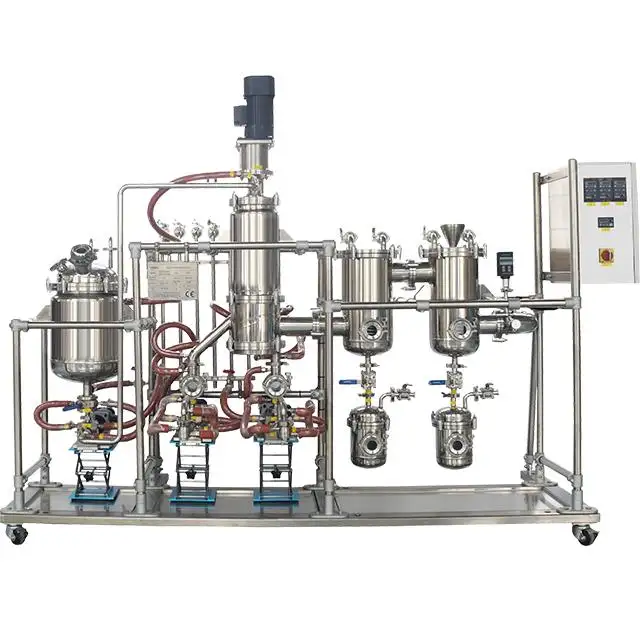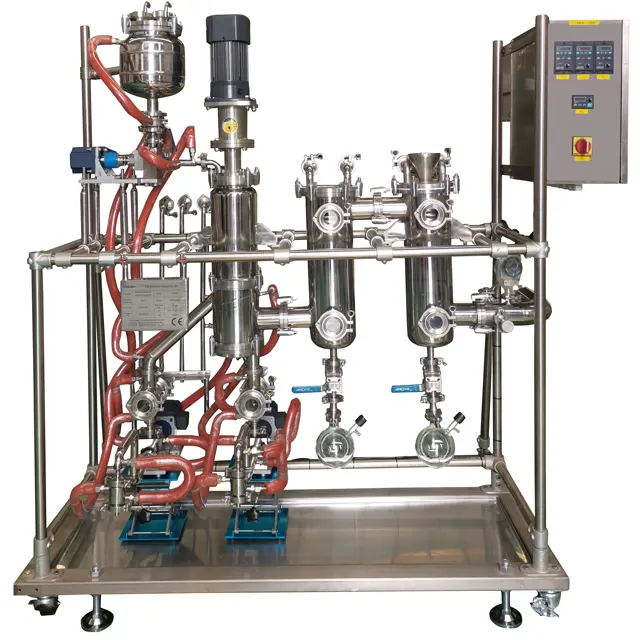How to Select Wiped Film Distillation for Temperature-Sensitive Compounds
Selecting the right Wiped Film Distillation system for temperature-sensitive compounds is a critical decision in industries like pharmaceuticals, cosmetics, and natural product processing. Temperature-sensitive compounds—such as vitamins, enzymes, essential oils, and pharmaceuticals—easily degrade when exposed to high heat, losing their potency, purity, or functionality. Wiped Film Distillation is uniquely suited for these materials because it operates under low temperatures and high vacuum, but choosing the right system requires careful consideration of key features. This guide outlines the steps to select Wiped Film Distillation equipment that protects temperature-sensitive compounds while ensuring efficient purification.
Understand the Needs of Your Temperature-Sensitive Compounds
Before selecting Wiped Film Distillation equipment, you must first understand the specific properties of the temperature-sensitive compounds you’re processing. This knowledge will guide your equipment choices. Ask these questions:
- What is the thermal stability of the compound? Identify the maximum temperature the compound can withstand without degrading. For example, some natural oils break down above 60°C, while certain pharmaceuticals may tolerate up to 120°C. This temperature limit will determine the required operating range of the Wiped Film Distillation system.
- What is the compound’s viscosity? Viscosity affects how easily the material can be spread into a thin film. High-viscosity compounds (like thick oils or pastes) require more robust wiping mechanisms, while low-viscosity liquids need gentle handling to avoid splashing.
- What purity level do you need? Temperature-sensitive compounds in pharmaceuticals often require 99%+ purity, while natural extracts may need lower but still strict standards. This affects the system’s separation efficiency requirements.
- Are there volatile impurities to remove? Some compounds contain volatile contaminants that need separation. Wiped Film Distillation separates based on volatility, so understanding impurity levels helps select equipment with the right vacuum and temperature controls.
By defining these properties, you can focus on Wiped Film Distillation systems designed to handle your specific temperature-sensitive compounds.
Prioritize Vacuum System Performance
Wiped Film Distillation relies on high vacuum to lower the boiling points of temperature-sensitive compounds, allowing separation at low temperatures. A strong vacuum system is therefore the most critical feature to protect these materials. When evaluating vacuum performance:
- Vacuum level range: Look for systems that achieve a vacuum level of 0.001 to 1 mmHg (millimeters of mercury). Lower pressure (higher vacuum) reduces boiling points further, minimizing heat exposure. For highly heat-sensitive compounds, aim for vacuums below 0.1 mmHg.
- Vacuum stability: Fluctuations in vacuum pressure can cause temperature spikes, risking degradation. Choose systems with advanced vacuum pumps (like diffusion pumps or turbomolecular pumps) and real-time pressure sensors that maintain stable vacuum levels throughout the process.
- Vacuum pump compatibility: Ensure the vacuum pump is suitable for your compounds. For example, oil-sealed pumps may contaminate high-purity pharmaceuticals, so dry vacuum pumps (oil-free) are better for such applications.
A reliable vacuum system ensures that your temperature-sensitive compounds vaporize at the lowest possible temperature, preserving their integrity.

Evaluate the Wiping Mechanism Design
The wiping mechanism in Wiped Film Distillation spreads the liquid into a thin, uniform film across the heated chamber wall. For temperature-sensitive compounds, this film must be thin enough to ensure rapid heat transfer (reducing contact time with heat) but uniform to avoid hot spots. Key features to check:
- Wiper type and material: Wipers should be made from materials that won’t react with your compounds (e.g., PTFE for corrosive materials, stainless steel for durability). Spring-loaded wipers maintain consistent contact with the chamber wall, ensuring even film distribution.
- Adjustable rotation speed: The wiper speed (measured in RPM) controls film thickness. Higher speeds create thinner films (better for heat-sensitive materials) but may cause splashing with low-viscosity liquids. Look for systems with variable speed controls (typically 50–500 RPM) to match your compound’s viscosity.
- Film thickness control: Optimal film thickness for temperature-sensitive compounds is 0.1–0.5 mm, minimizing heat exposure. The wiping mechanism should reliably produce this thickness without unevenness, which can lead to local overheating.
A well-designed wiping mechanism reduces the time your temperature-sensitive compounds spend in contact with heat, lowering degradation risk.
Check Temperature Control Precision
Even with high vacuum, precise temperature control is essential to avoid overheating temperature-sensitive compounds. The Wiped Film Distillation system must heat the chamber wall and cool the condenser with accuracy. Focus on these factors:
- Heating method: Jacketed heating (using oil or water) provides uniform temperature distribution, which is critical for avoiding hot spots. Oil heating is better for higher temperatures, while water-based systems work for lower ranges. Electric heating is also an option but may have more uneven heat distribution.
- Temperature range and accuracy: The system’s heating range should be adjustable to match your compound’s thermal limit (e.g., 40–150°C for highly sensitive materials). Controllers should maintain temperatures within ±0.5°C to prevent fluctuations that could damage compounds.
- Condenser efficiency: The condenser must quickly cool vaporized compounds to prevent re-vaporization or degradation. Look for systems with large condenser surface areas and adjustable cooling (using water or refrigerants) to ensure rapid condensation.
Precise temperature control ensures that temperature-sensitive compounds are heated only enough to vaporize, without exceeding their stability limits.
Assess Material Compatibility
The materials used in Wiped Film Distillation equipment must be compatible with your temperature-sensitive compounds to avoid contamination or chemical reactions. This is especially important for high-purity applications like pharmaceuticals:
- Chamber material: The distillation chamber should be made from inert, corrosion-resistant materials. 316L stainless steel is a standard choice for most compounds, as it resists rust and chemical reactions. For highly reactive materials, consider glass-lined chambers or Hastelloy (a nickel-based alloy).
- Wipers and seals: Wipers and seals should be made from materials like PTFE or Viton, which are inert and heat-resistant. Avoid materials that could leach into the product or react with temperature-sensitive compounds (e.g., rubber seals may degrade and contaminate oils).
- Surface finish: A smooth, polished chamber surface reduces friction, helping the wiping mechanism spread the film evenly. It also makes cleaning easier, preventing residue buildup that could contaminate future batches of temperature-sensitive compounds.
Material compatibility protects both your compounds and the equipment, ensuring purity and extending system lifespan.
Consider System Scale and Throughput
Wiped Film Distillation systems come in various sizes, from lab-scale units to industrial machines. Select a scale that matches your production needs while protecting temperature-sensitive compounds:
- Lab-scale systems: For small batches or research (processing 0.1–5 liters per hour), these compact systems offer precise control for testing new temperature-sensitive compounds. They are ideal for optimizing parameters like vacuum level and wiper speed before scaling up.
- Pilot-scale systems: Designed for medium volumes (5–50 liters per hour), these bridge lab and production. They help validate processes for temperature-sensitive compounds in larger quantities, ensuring scalability without quality loss.
- Industrial-scale systems: For high-volume production (50+ liters per hour), these systems feature robust vacuum and heating systems, automated controls, and large chambers. They maintain the low-temperature conditions needed for temperature-sensitive compounds even during continuous operation.
Choose a scale that meets current needs but allows for growth, as upgrading later can disrupt production and require revalidation of processes for temperature-sensitive compounds.
Look for Automation and Safety Features
Automation and safety features reduce human error and protect temperature-sensitive compounds from accidental overheating or pressure spikes:
- Automated controls: Systems with PLC (Programmable Logic Controller) or touchscreen interfaces let you pre-set vacuum, temperature, and wiper speed parameters. This ensures consistent processing and reduces the risk of manual adjustments that could harm compounds.
- Safety alarms: Alarms for high temperature, low vacuum, or motor failure alert operators to issues before they damage temperature-sensitive compounds. Automatic shutdown features can stop the process if critical parameters go out of range.
- Data logging: Systems that record process data (temperature, vacuum, time) help track batch quality and comply with regulatory requirements (e.g., in pharmaceuticals). This is essential for validating that temperature-sensitive compounds were processed within safe limits.
Automation and safety features provide peace of mind, ensuring that even with operator changes, your temperature-sensitive compounds are processed correctly.
Evaluate Supplier Support and Expertise
Selecting Wiped Film Distillation equipment for temperature-sensitive compounds requires working with a supplier who understands your needs. Look for these qualities:
- Industry experience: Suppliers with expertise in processing temperature-sensitive compounds (e.g., pharmaceuticals or natural extracts) can recommend tailored solutions and share best practices.
- Technical support: Ensure the supplier offers training for your team to operate the system correctly, as improper use can damage temperature-sensitive compounds. They should also provide prompt support for troubleshooting.
- Customization options: If your compounds have unique needs (e.g., ultra-low temperature requirements or high viscosity), check if the supplier can customize the system (e.g., adding a better vacuum pump or specialized wipers).
- Warranty and maintenance: A strong warranty (1–2 years) and access to spare parts (like wipers or seals) minimize downtime. Suppliers should offer maintenance plans to keep the system operating at peak performance.
FAQ
What vacuum level is best for highly temperature-sensitive compounds?
For highly sensitive materials, aim for a vacuum level below 0.1 mmHg. This lowers boiling points significantly, allowing separation at temperatures 50–100°C lower than at atmospheric pressure.
How does wiper speed affect temperature-sensitive compounds?
Higher wiper speeds create thinner films, reducing heat contact time and lowering degradation risk. Adjust speed based on viscosity: higher speeds for thick liquids, lower speeds for thin ones to avoid splashing.
Can Wiped Film Distillation handle high-viscosity temperature-sensitive compounds?
Yes, but choose systems with robust, adjustable wipers (e.g., spring-loaded blades) and higher rotation speeds to spread thick materials into a thin film.
Is stainless steel safe for temperature-sensitive pharmaceutical compounds?
Yes, 316L stainless steel is inert and meets pharmaceutical standards. For extra purity, some systems use electropolished stainless steel to reduce surface roughness and contamination risk.
How often should Wiped Film Distillation systems be maintained for temperature-sensitive processing?
Regular maintenance (every 3–6 months) is critical. This includes cleaning the chamber, replacing worn wipers/seals, and servicing the vacuum pump to ensure stable performance and protect compounds.
Table of Contents
- Understand the Needs of Your Temperature-Sensitive Compounds
- Prioritize Vacuum System Performance
- Evaluate the Wiping Mechanism Design
- Check Temperature Control Precision
- Assess Material Compatibility
- Consider System Scale and Throughput
- Look for Automation and Safety Features
- Evaluate Supplier Support and Expertise
-
FAQ
- What vacuum level is best for highly temperature-sensitive compounds?
- How does wiper speed affect temperature-sensitive compounds?
- Can Wiped Film Distillation handle high-viscosity temperature-sensitive compounds?
- Is stainless steel safe for temperature-sensitive pharmaceutical compounds?
- How often should Wiped Film Distillation systems be maintained for temperature-sensitive processing?

